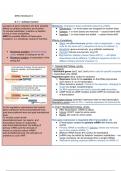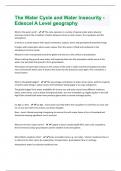6.1.1 - Cellular Control
(a) types of gene mutations and their possible Mutations: Changes to base nucleotide sequence of DNA
effects on protein production and function. ● Substitution: 1 or more bases are swapped for another base
To include substitution, insertion or deletion ● Deletion: 1 or more bases are removed → causes frame-shift
of one or more nucleotides ● Insertion: 1 or more bases are added → causes frame-shift
AND the possible effects of these gene
mutations (i.e. beneficial, neutral or harmful).
Effects of mutations:
● Silent: no effect because genetic code is degenerate → may
code for the same AA (1) sequence of AA is not altered (1)
● Beneficial: gives survival adv. (e.g antibiotic resistance)
● Nonsense mutation: becomes a stop ● Harmful: reduces survival adv. (e.g CF)
codon instead of coding for an AA ● E.g insertion/ deletion causes frame-shift (1) → all triplets
● Missense mutation: incorporation of the downstream will be different (1) different sequence of AAs (1)
wrong AA different tertiary structure of protein (1)
1) TRANSCRIPTIONAL LEVEL
Lac Operon:
3 structural genes (lacZ, lacY, lacA) which code for specific enzymes
+ transcribed onto mRNA
Regulatory gene (lacI) codes for repressor
1) Repressor binds to the operator so that RNA polymerase
can’t bind to it, so no transcription
2) When lactose is present, it binds to the repressor, changing its
shape (no longer complementary)
● So RNA polymerase can bind to promoter and transcribes
3) cAMP binds to cAMP receptor protein (CRP) to increase rate
of transcription
Transcription factors (activator/ repressor) start or stop transcription
Regulatory genes code for TFs + controls expression of structural Gs
(b) the regulatory mechanisms that control 2) POST-TRANSCRIPTIONAL LEVEL
gene expression at the transcriptional level, ● After transcription, mRNA is edited
post-transcriptional level and post-translational ● Introns: DON’T code for amino acids
level. ● Exons: DO code for amino acids
To include control at the
transcriptional level: lac operon, and How gene expression is regulated after transcription. (3)
transcription factors in eukaryotes ● [Transcription creates the primary mRNA with introns and
post-transcriptional level: the editing of exons]
primary mRNA and the removal of ● Primary mRNA is modified (1) Splicing: introns are removed
introns to produce mature mRNA are to form mature mRNA (1)
post-translational level: the activation of ● [Mature mRNA leaves the nucleus for translation]
proteins by cyclic AMP. ● [mRNA may be edited by deletion/ insertion/ substitution → so
range of proteins can be produced from a single mRNA]
● Alternative splicing produces different versions of mRNA (1)
, 1) Transcriptional level → genes switch on/off 3)[Extra]: TRANSLATIONAL LEVEL
2) Post-transcriptional level → introns ● Degradation of mRNA → the more resistant, the longer it stays
removed from primary mRNA to form in the cytoplasm → greater quantity of enzymes synthesised
mature mRNA ● Inhibitory proteins binds to mRNA → prevent mRNA from
3) Post-translational level → modification to
binding to ribosomes
the protein synthesised
● Activation of initiation factors → help mRNA bind to ribosomes
E.g protein kinase:
Explain why some regions of DNA can be
● Activated by cAMP (1) + catalyses phosphorylation of proteins
described as ‘non-coding’ (2)
● Binding of cAMP alters T structure (1) + function
● Primary mRNA is edited (1)
● Not present in the mature mRNA (1)
4) POST-TRANSLATIONAL LEVEL
● Not translated (1)
● Modification to the proteins synthesised
● E.g Addition of non-protein groups (e.g carbs, lipids)/
How gene expression is regulated after
modifying bonds like disulfide bonds/ modification + activation
transcription. (3)
by cAMP
● Primary mRNA is modified (1) splicing
E.g cAMP:
removes introns to form mature mRNA
● Molecules (primary messengers) bind to specific receptors on
(1)
PM and trigger production of cAMP
● Protein is activated by cAMP (1) binding
● cAMP activates proteins inside the cell by altering its tertiary
changes tertiary structure (1)
structure (e.g active site)
(c) the genetic control of the development of Hox genes: group of homeobox genes, responsible for correct
body plans in different organisms. Homeobox positioning of body parts in animals + found in clusters in mammals
gene sequences in plants, animals and fungi Homeobox genes: groups of genes, which all contain a homeobox +
are similar and highly conserved AND the role
are regulatory genes (code for TFs)
of Hox genes in controlling body
plan development. Homeobox: is a highly conserved section of DNA (180 base pairs
Suggest two other reasons why fruit flies long) + codes for the homeodomain (60 AA long)
are chosen for research (2) Homeodomain: is a part of the protein coded + binds to DNA,
● Rapid reproduction rate (1) switching genes on/ off
● Low cost (1) State what is meant by homeobox gene (2)
● Genetic development is well understood ● Contains 180 bp/ codes for homeodomain/ bind to DNA/
(1)
switches genes on or off
It’s highly conserved because genes are very important (1) mutations
would have a big impact on the body plan (1)
(d) the importance of mitosis and apoptosis as Apoptosis: Programmed cell death & removes unwanted cells and
mechanisms controlling the development of tissues
body form. To include an appreciation that the ● Hox genes produce transcription factors
genes which regulate the cell cycle and
● Cells produce molecules which signal for apoptosis which
apoptosis are able to respond to internal and
external cell stimuli e.g. stress. stimulate mitosis for remodelling
How failure of control mechanisms can lead ● Nucleus condenses and becomes fragmented → cell shrinks +
to deformities (3) blebs form → breaks down into apoptotic bodies → phagocyte
● Hox genes don’t produce TFs (1) engulfs apoptotic bodies
● Molecules signalling apoptosis not ● Hox genes control mitosis and apoptosis
produced (1) Cells between fingers undergo apoptosis, → remodelled by mitosis
● Apoptosis doesn’t occur [e.g between
fingers] (1)
, 6.1.2 - Patterns of Inheritance
(a) (i) the contribution of both environmental Both environmental and genetic factors contribute to phenotypic
and variation.
genetic factors to phenotypic variation.
Chlorosis Body mass
To include examples of both genetic and
environmental contributions – Not producing enough Low/ high body mass due to…
environmental examples could include chlorophyll due to…
diet in animals and etiolation or chlorosis Genetic: Genetic:
in plants. ● Have genes coding for ● Obesity due to genetic
(ii) how sexual reproduction can lead to making chlorophyll makeup → altered
genetic variation within a species. Environmental: patterns of fat deposition
Meiosis and the random fusion of ● BUT lack of light, mineral Environmental:
gametes at fertilisation. deficiency (Mg/ Fe), viral ● Diet, exercise, disease
infections
Genetic variation comes from… ii) Discuss the ways in which genetic variation is produced,
● Different alleles for the same gene including the role of nuclear division (9)
● During meiosis - independent ● Independent assortment of chromosomes (1) in metaphase I
assortment/ cross-over + chiasmata (1) homologous chromosomes have different alleles (1)
forming Produces large no. of allele combinations (1)
● Random fusion of gametes at ● Cross over (1) in prophase I (1) chromatids have a new
fertilisation combination of alleles (1)
● Mutation (1) changes base sequence (1) different proteins (1)
● Random fusion of gametes (1) gametes aren’t genetically
identical (1)
(b) (i) genetic diagrams to show patterns of i) Monogenic inheritance
inheritance. ● Inheritance of a single gene
To include monogenic inheritance, [KNOW HOW TO DRAW A GENETIC CROSS/ PUNNETS SQUARE]
dihybrid inheritance, multiple alleles, sex
Dihybrid inheritance
linkage and codominance.
(ii) the use of phenotypic ratios to identify ● Inheritance of two different genes
linkage (autosomal and sex linkage) ● For a cross of 2 heterozygous parents, typically 9:3:3:1
and epistasis. Multiple alleles
To include explanations of linkage and ● A gene can have more than 2 versions (alleles)
Epistasis. ● E.g blood group where A & B are dominant, O is recessive
Codominance
Typical ratios: ● When 2 alleles are equally dominant so both are expressed
Dihybrid epistasis ● E.g For flowers, red (A) + white (B) → pink (AB)
Hetero x Hetero → (9 : 3 : 3 : 1) Sex-linked
● Genes carried in sex chromosomes determines certain
Recessive epistasis: characteristics (e.g haemophilia)
Hetero x Hetero → (9 : 3 : 4) ● Since Y is smaller, males may have 1 copy of the gene from
the X → e.g a recessive allele expressed as there’s no
Dominant epistasis
Hetero x Hetero → (12 : 3 : 1) dominant allele on the Y
ii) Autosomal linkage: Same loci on the same chromosome (1)
Sex-linked
Males have 1 copy of the gene (1) Affected







